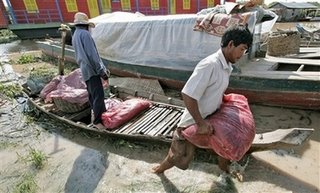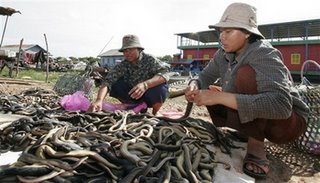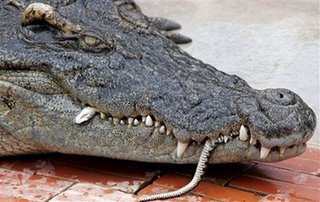 Cambodian Snake hunter Ly Vy, 26, collects snakes from his nets in the dense flooded jungle on the Tonle Sap lake near Siem Reap, Cambodia, Tuesday, Aug. 1, 2006. Ly Vy collects about 10 pounds of snakes each day, earning about one U.S. dollar for his efforts. (AP Photo/David Longstreath)
Cambodian Snake hunter Ly Vy, 26, collects snakes from his nets in the dense flooded jungle on the Tonle Sap lake near Siem Reap, Cambodia, Tuesday, Aug. 1, 2006. Ly Vy collects about 10 pounds of snakes each day, earning about one U.S. dollar for his efforts. (AP Photo/David Longstreath)  A Cambodian worker unloads one of many sacks of harvested water snakes at Neak Krorhorm, Cambodia, Tuesday, Aug. 1, 2006. Millions of water snakes are harvested during the monsoon season from the Tonel Sap lake. (AP Photo/David Longstreath)
A Cambodian worker unloads one of many sacks of harvested water snakes at Neak Krorhorm, Cambodia, Tuesday, Aug. 1, 2006. Millions of water snakes are harvested during the monsoon season from the Tonel Sap lake. (AP Photo/David Longstreath) Cambodians gather to sort harvested water snakes, Aug. 1, 2006, at Neak Krorhorm, Cambodia, a port near Siem Reap. Researchers for the Wildlife Conservation Society estimate nearly 4 million snakes are plucked out each year, and fear that number can't sustain the snake population. (AP Photo/David Longstreath)
Cambodians gather to sort harvested water snakes, Aug. 1, 2006, at Neak Krorhorm, Cambodia, a port near Siem Reap. Researchers for the Wildlife Conservation Society estimate nearly 4 million snakes are plucked out each year, and fear that number can't sustain the snake population. (AP Photo/David Longstreath) A Cambodian worker tosses water snakes to awaiting Siamese crocodiles, Wednesday, Aug. 2, 2006, in Siem Reap, Cambodia. Harvested water snakes are a popular source of food local crocodile breeders. (AP Photo/David Longstreath)
A Cambodian worker tosses water snakes to awaiting Siamese crocodiles, Wednesday, Aug. 2, 2006, in Siem Reap, Cambodia. Harvested water snakes are a popular source of food local crocodile breeders. (AP Photo/David Longstreath) A Siamese crocodile snaps up a water snake, Wednesday, Aug. 2, 2006, at a crocodile farm in Siem Reap, Cambodia. Water snakes harvested from the Tonle Sap lake are a popular source of food sought out by Cambodian crocodile breeders. (AP Photo/David Longstreath)
A Siamese crocodile snaps up a water snake, Wednesday, Aug. 2, 2006, at a crocodile farm in Siem Reap, Cambodia. Water snakes harvested from the Tonle Sap lake are a popular source of food sought out by Cambodian crocodile breeders. (AP Photo/David Longstreath)2006-08-17
By DENIS D. GRAY
PREK TOAL, Cambodia (AP) - Deep inside a flooded forest oozing with wildlife, Ly Vy pries another struggling creature from a gill net, whacks its head against the side of his skiff and adds it to a coiled heap that will add to the world's largest snake harvest.
A day later and across the Tonle Sap, the vast lake that is Cambodia's most vital ecosystem, it's not a very pretty sight. Bucketfuls of lifeless water snakes are tossed into algae-green pools and pits seething with crocodiles, which gulp them down in a few power-packed bites.
Some of the farm's 2,000 crocs fall back into their almost continual sleep with bits of snake still dangling from their clamped jaws.
"They prefer snakes over fish. They have red blood and good protein," says Sen Rith, owner of one of Cambodia's 900 or so crocodile farms, which are growing increasingly dependent on snakes as stocks of fish are depleted in the Tonle Sap's once bountiful waters.
Researchers for the Wildlife Conservation Society estimate nearly 4 million snakes are plucked out each year, and fear that number can't sustain the snake population. That raises concerns among both the thousands who make their living off the catch and environmentalists monitoring the fragile and already battered lake.
"The snakes have got to be rated as forming one of the most important components of the ecology of the Tonle Sap," says Joe Walston, who heads the New York-based society's operation in Cambodia.
"They are an important predator, but also an important food source for large raptors, wild crocs (and other animals). If they were to decline the effects would be devastating on some of the world 's most important colonies of water birds and other wildlife."
Ly Vy, who has been catching the nonpoisonous snakes for eight years, says there are far fewer these days, and worries both about future catches and possible government controls on the harvest. This year, he has been catching about half the number over last season, which peaks between June and September.
During these months of the monsoons, he lives with his wife and two young boys aboard a cramped, open-decked 4.5-meter-long (nearly 15-foot-long) boat deep inside the humid, insect-ridden forest. He and other snake hunters, among the nation's poorest folk, spend the rest of the year as fishermen on the lake in northwestern Cambodia.
"During this season we can't catch a lot of fish so we try to catch a lot of snakes," the 26-year-old hunter says as he finishes the morning's inspection of his 400-meter-long (1,300-foot-long) net strung along a narrow water channel. The 50 animals collected, the endemic Tonle Sap water snake among them, will fetch him about 4,000 riel (US$1 or 80 euro cents), he says.
"It's difficult to live in the forest, but we have no choice. The children can't go to school, medical help is far away and the food is poor," says his wife, Hol Hong, noting that snake is on their menu day after day.
To a visitor, the family's environment seems anything but unpleasant.
Dozens of spot-billed pelicans, a species endangered around the globe, rise with powerful beats of wings, then skim gracefully over the water. Gray-headed fishing eagles watch broodingly from treetops, while spear-sleek cormorants flap over muddy waters burbling with eggs, seeds, spores, larvae and hatchlings.
This unique ecosystem forms each year as the Tone Sap expands to five times its dry season size to flood tropical forests and farm land around Southeast Asia's largest lake and is the source of at least 60 percent of Cambodia's protein intake.
From this primordial incubator slither millions of water snakes from five species of the subfamily Homalopsinae.
Most of the catch goes to crocodile farms. Other snakes are turned into wallets, handbags and other luxury products. Some are exported or sold locally to restaurants where they are fried, dried, boiled and curried, a pregnant female being considered a special delicacy.
"We do know that the intensity of the harvest is going up and the quantity of snakes being brought into the ports and markets is going down," says Walston, a wildlife biologist.
It's not certain whether a point of no return has already been reached, he says, but some species like the Bocourt's water snake, valued for both its skin and meat, are now rarely found.
Walton says it is essential to have tighter regulations that take into account both the livelihoods of the hunters and the lake ecology. The rules might include protected breeding areas and restrictions on how snakes are caught.
If fishing and snake hunting don't remain sustainable, impoverished lake dwellers will inevitably turn to cutting down the forest and competing for other already dwindling resources, he says - and Cambodia's greatest environmental battle will be lost.
A day later and across the Tonle Sap, the vast lake that is Cambodia's most vital ecosystem, it's not a very pretty sight. Bucketfuls of lifeless water snakes are tossed into algae-green pools and pits seething with crocodiles, which gulp them down in a few power-packed bites.
Some of the farm's 2,000 crocs fall back into their almost continual sleep with bits of snake still dangling from their clamped jaws.
"They prefer snakes over fish. They have red blood and good protein," says Sen Rith, owner of one of Cambodia's 900 or so crocodile farms, which are growing increasingly dependent on snakes as stocks of fish are depleted in the Tonle Sap's once bountiful waters.
Researchers for the Wildlife Conservation Society estimate nearly 4 million snakes are plucked out each year, and fear that number can't sustain the snake population. That raises concerns among both the thousands who make their living off the catch and environmentalists monitoring the fragile and already battered lake.
"The snakes have got to be rated as forming one of the most important components of the ecology of the Tonle Sap," says Joe Walston, who heads the New York-based society's operation in Cambodia.
"They are an important predator, but also an important food source for large raptors, wild crocs (and other animals). If they were to decline the effects would be devastating on some of the world 's most important colonies of water birds and other wildlife."
Ly Vy, who has been catching the nonpoisonous snakes for eight years, says there are far fewer these days, and worries both about future catches and possible government controls on the harvest. This year, he has been catching about half the number over last season, which peaks between June and September.
During these months of the monsoons, he lives with his wife and two young boys aboard a cramped, open-decked 4.5-meter-long (nearly 15-foot-long) boat deep inside the humid, insect-ridden forest. He and other snake hunters, among the nation's poorest folk, spend the rest of the year as fishermen on the lake in northwestern Cambodia.
"During this season we can't catch a lot of fish so we try to catch a lot of snakes," the 26-year-old hunter says as he finishes the morning's inspection of his 400-meter-long (1,300-foot-long) net strung along a narrow water channel. The 50 animals collected, the endemic Tonle Sap water snake among them, will fetch him about 4,000 riel (US$1 or 80 euro cents), he says.
"It's difficult to live in the forest, but we have no choice. The children can't go to school, medical help is far away and the food is poor," says his wife, Hol Hong, noting that snake is on their menu day after day.
To a visitor, the family's environment seems anything but unpleasant.
Dozens of spot-billed pelicans, a species endangered around the globe, rise with powerful beats of wings, then skim gracefully over the water. Gray-headed fishing eagles watch broodingly from treetops, while spear-sleek cormorants flap over muddy waters burbling with eggs, seeds, spores, larvae and hatchlings.
This unique ecosystem forms each year as the Tone Sap expands to five times its dry season size to flood tropical forests and farm land around Southeast Asia's largest lake and is the source of at least 60 percent of Cambodia's protein intake.
From this primordial incubator slither millions of water snakes from five species of the subfamily Homalopsinae.
Most of the catch goes to crocodile farms. Other snakes are turned into wallets, handbags and other luxury products. Some are exported or sold locally to restaurants where they are fried, dried, boiled and curried, a pregnant female being considered a special delicacy.
"We do know that the intensity of the harvest is going up and the quantity of snakes being brought into the ports and markets is going down," says Walston, a wildlife biologist.
It's not certain whether a point of no return has already been reached, he says, but some species like the Bocourt's water snake, valued for both its skin and meat, are now rarely found.
Walton says it is essential to have tighter regulations that take into account both the livelihoods of the hunters and the lake ecology. The rules might include protected breeding areas and restrictions on how snakes are caught.
If fishing and snake hunting don't remain sustainable, impoverished lake dwellers will inevitably turn to cutting down the forest and competing for other already dwindling resources, he says - and Cambodia's greatest environmental battle will be lost.

























1 comment:
Snake play also play a major role in controlling rats and mouse population too!
Cambodian can't even keep what they have and now they are forced to take away the very thing that support their life line! This is not how you live as a human being!
Cambodia need a new economic model!
Cambodia need a new economic liberation for all Cambodian people!
Post a Comment